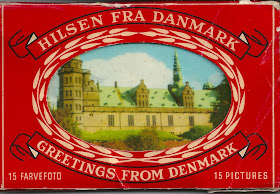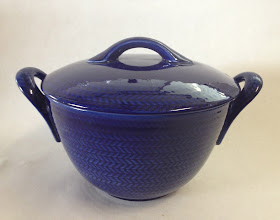 |
| Souvenir cards from Denmark, 1960. The image shown depicts Frederiksborg Slot in Hillerød |
The Auckland auction house Art+Object is currently promoting
its forthcoming modern design auction. The sale – to be held on 4 July
2013 – includes a selection of Scandinavian-designed furniture, including
chairs by Hans Wegner, Børge Mogensen, Orla Mølgaard-Nielsen and Peter Hvidt
and a FA 66 sideboard (lot 463) designed by Ib Kofod-Larsen (mistakenly
identified in the catalogue as Kofed Larsen) for Faarup Møbelfabrik I/S (not identified in the catalogue). It’s
all good quality stuff, although you regret the absence of any reference to
provenance in the lot descriptions: were these pieces imported into New Zealand
contemporaneously; or do they have a more recent acquaintance with the
country; were they a manifestation of New Zealand's earlier fascination with Scandinavia, or a more recent iteration of that phenomenon?
 |
New Zealand House, Haymarket, London
seen from Trafalgar Square
|
In the period following the second world war, the export
success of Scandinavian design was the envy of manufacturing interests around
the world. Even in New Zealand, Scandinavian design garnered recognition, sometimes from
the most unlikely of quarters. In an effort to add a sophisticated gloss to the
soon to be completed New Zealand House (Robert Matthew, Johnson Marshall &
Partners, 1963) in London, the New Zealand government specified Scandinavian-designed
objects for its fit out. Writing about the building in 2005, Harriet Atkinson records that: ‘Furniture, crockery and glass were part of the architect’s
planning, the majority bought from Scandinavian manufactures. The furniture was
designed by Kjærholm, Ekselius, Wegner, Matheson and Finn Juhl; the crockery
by Rörstrand; and the glass by Orrefors.’ Sadly, none of this cornucopia of designed objects remains in the
parts of the building still occupied by the New Zealand High Commission in
London.
One of the earliest New Zealand
references to Scandinavian design occurred in the New Zealand Design Review in its October-November 1952 issue. Beatrice
Ashton (1920-1999), a regular contributor on design matters, recalled a rumour she had
heard that ‘a Swedish craftsman was working in wood in Havelock North.’
Commenting that it ‘seemed an unlikely idea and an unlikely place to find such
a man’, she visited him: ‘Right in the centre of Havelock North we found an enchanting
shop. We felt suddenly that we were in San Francisco again (she'd passed through California in February 1944) except that the
goods in the window were unmistakeably Swedish.’
De Flon’s enterprise failed when, in
1952, a new licensing schedule introduced by the New Zealand Board of Trade
‘had dried up his supply of Swedish glass and pottery’; the schedules were
allocated in part on the basis of an applicant’s import history; de Flon had no
such history and he appears to have closed the shop and returned to Sweden.
 |
Covered bowl from the Blå Eld (Blue Fire) range,
designed by Hertha Bengston for Rörstrand in 1950,
retailed in Auckland by Patrick Pierce
|
More experienced retailers such as Dan
Pierce, who sold ceramics and glass as Patrick Pierce in central Auckland
and suburban Takapuna, did have a history and managed to circumvent import
restrictions favouring British suppliers and was selling Rörstrand ceramics and
Orrefors glass to discerning Aucklanders in the mid 1950s.
A more viable translation of
Scandinavian design to New Zealand occurred in the mid 1950s when Ken and Bente
Winter from Århus in Denmark set
up as manufacturers of economically-priced furniture in Auckland, eventually opening a retail outlet in Symonds Street in 1962. Two years later they
launched the brand ‘Danske Møbler’ (Danish for Danish furniture) in 246 (Rigby Mullan, 1964), a
multi-storey vertical shopping mall with up-market aspirations located at 246 Queen Street, Auckland’s main retail strip, that had been developed by
the theatrical entrepreneur Robert Kerridge. While its current output gives no indication of its Danish origins –
other than its name – the company still survives as a local manufacturer.
 |
Interior view of the Smith-Sutch house designed by Ernst Plischke.
Unidentified photographer, published in the Architectural Review,
October 1959
|
Probably the greatest advocate of Scandinavian
design in New Zealand during the 1950s and early 1960s was Dr William Ball
Sutch, an economist, historian, collector and a noted patron of good design;
his house in Brooklyn was designed by Ernst Plischke (1953-56). But as
assistant secretary in the Department of Industries and Commerce, Sutch’s
concern with Scandinavian design wasn’t about aesthetics but rather about the way it could be seen as an exemplar for New Zealand as it sought to maintain its then enviable material living standards.
In a wide ranging speech delivered to the January 1957 Dunedin conference of
the Australian and New Zealand Association for the Advancement of Science,
Sutch declared that:
As the country grows,
New Zealand’s main assets can only be the skill, experience and intelligence of
her people Small countries like Finland, Denmark or Switzerland have even fewer
natural resources than we have. Yet because of the skill of their people hey
are important manufacturing countires […] New Zealand’s preoccupation with the
tariff may be too negative an approach. Should we not be concerned with
producing goods which have as their main ingredient not raw materials but
brains and skills. (W B Sutch, The next two decades of manufacturing in New Zealand, 1957, p. 21)
Sutch’s pleas fell, for the moment, on
deaf ears: the National party government was panicking to ensure that in the
face of Britain’s effective abandonment of its economic empire ‘there were
secure and remunerative outlets for the nation’s agricultural surplus.’
The re-election of a Labour
administration in November 1957 gave Sutch, who was shortly after appointed
secretary of the Department of Industries and Commerce, an opportunity to
pursue his interest in seeing how Scandinavian we could be. Soon after his
elevation Sutch established a design study group within the department charged with researching the possibility of establishing a design promotion body, that he anticipated would be loosely modelled either on the
British Council of Industrial Design or the recently established Industrial Design Council of Australia. Following the study group’s work, Sutch
realised that neither the British nor the Australian templates were appropriate to the New Zealand situation and turned to Denmark for inspiration. Writing in 1963 to the
departing Danish chargé d’affaires, Thorkild Wegener-Clausen, Sutch opined that
‘Denmark must be one of the examples
which New Zealand must follow if it is to develop as a mature nation with a
continuing good living standard.’ In practical terms, Sutch concluded that the model
offered by Den Permanente, a
retailing display centre of Danish craft and design in Copenhagen, would be the
best way of encouraging and promoting design in New Zealand.
 |
Two wooden mice, designed by Theodore Skjøde Knudsen, made by Skjøde Skern I/S,
retailed by Den Permanente and bought by an Auckland tourist in Copenhagen in August 1961 |
Formed in 1931 by the Landsforeningen Dansk Kunsthåndværk (the Danish Society of Craft), Den Permanente ‘was an association, not a business. The exhibitors were members who elected the board […] It arranged special exhibitions, and during the 1950s and the beginning of the 1960s Den Permanente became well known as far away as Japan and the US. Approximately 75 per cent of the sales went abroad, primarily to the US’ (Per H Hansen, The construction of a brand: the case of Danish design, 1930-1970). Sutch speculatively felt that this combination of craft and industrial production was more appropriately suited to the situation prevailing in New Zealand. This contention was driven by the idea that the local recreation of something like Den Permanente might start making New Zealand producers and consumers more conscious of design.
Sadly, it was not to be. The National
party administration elected in November 1960 forced Sutch into retirement in
March 1963 - his politics were deemed to be too radical and the minister, John Marshall, loathed and feared him. The design promotion body that eventually emerged in 1966, The New Zealand Industrial Design Council, was an anaemic replica of the British model. Despite early successes under its first director, Geoffrey Nees, it was invariably under-resourced and its existence was always under threat. It was abolished in 1988; never was Scandinavia
so distant from New Zealand. It would take the Nokia success story of the 1990s
for New Zealand to start, hopelessly and unthinkingly, aspiring once again to be the
Scandinavia of the south.








